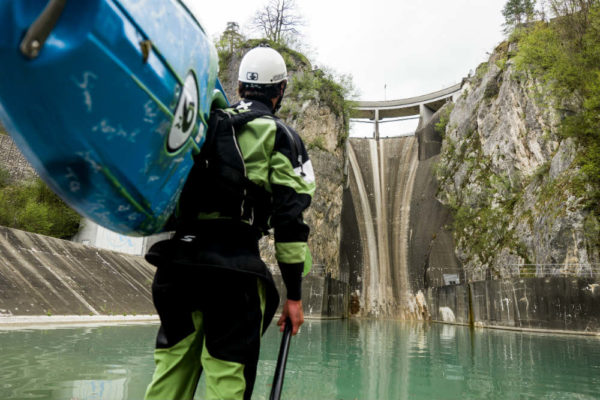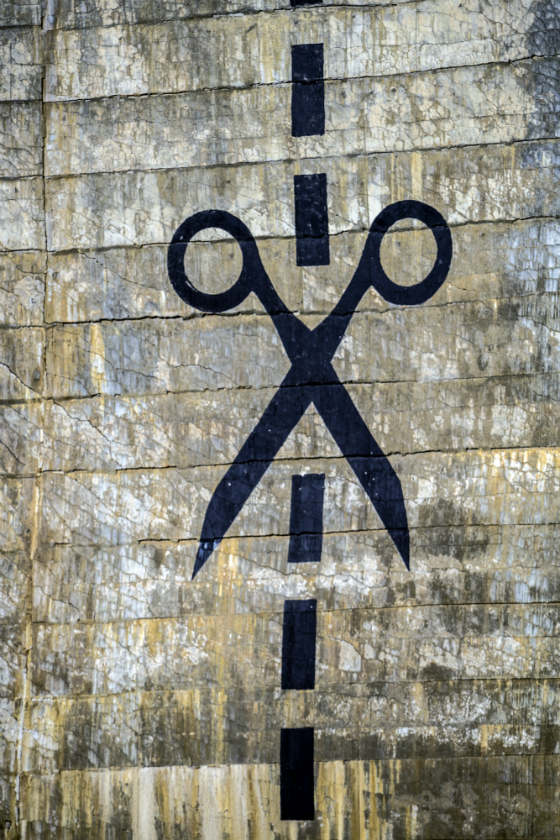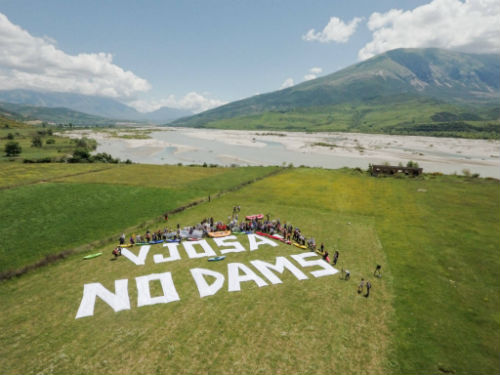OUTSIDE IN | By Bennett Barthelemy
Dam Nation: Finding The Lucky Path from Matilija Dam to the Blue Heart of Europe
Rok Rozman, leader of the Balkan Rivers Tour, stands in front of the first dam on the river that defines the Balkan Peninsula, Sava River, his home river. Determined that there will be no new ones he, together with fellow kayakers and fishermen, paddled down the river and organized a protest afterwards.
 This continual flow of data and experience spins inexorably inward. If we are lucky, at a certain point of intensity this spinning kicks out the superfluous. Our internal Coriolis effect of ideas and intention eventually hits a nadir. Or maybe it is an apex, or an equator perhaps – and flips. It slowly oscillates the other way and begins colliding, collecting ideas and associations, linking passions with strangers that may be similarly aligned. Awareness expands with the collected synergy, these refreshed landscapes vivify with color, contrast and clarity and the senses renewed. These seeds of wonder finding fertile soil sewn, rooted, sprouted and fruits shared. We are all waves upon this flowing river reaching the vast sea, this collective economy of the ideal sustaining and nurturing.
This continual flow of data and experience spins inexorably inward. If we are lucky, at a certain point of intensity this spinning kicks out the superfluous. Our internal Coriolis effect of ideas and intention eventually hits a nadir. Or maybe it is an apex, or an equator perhaps – and flips. It slowly oscillates the other way and begins colliding, collecting ideas and associations, linking passions with strangers that may be similarly aligned. Awareness expands with the collected synergy, these refreshed landscapes vivify with color, contrast and clarity and the senses renewed. These seeds of wonder finding fertile soil sewn, rooted, sprouted and fruits shared. We are all waves upon this flowing river reaching the vast sea, this collective economy of the ideal sustaining and nurturing.
If we are unlucky we swim headfirst into a concrete wall. We stagnate, we ossify and much of what is around us becomes compromised. When the flow slows we suffer, when it stops we die.
If we were to pick a physical object that we can all relate to, that exemplifies the unlucky path, some would choose a bottle – or if we got radical maybe a church or the White House. I will choose a dam. It is difficult to envision a better way to clog an artery and slowly choke life across the riverine landscape than this shunt of ground up stone, with the dendritic byways that can feed and nourish far from the heart and brain, diverted or cut off. The profusion and promise, the energy and the hope that sustains this collective heartbeat, this unique watershed, sacrificed.
Orbits are an interesting concept when applied to human interaction. We may fly by making eye contact in the space of seconds, or we might collide throwing each other upon the stifling shore of regret for a while before the floods of renewal find us. Or maybe we harmonically converge our trajectories and share space for a while… Rivers can be a catalyst for these interactions as well as exemplify them. Rivers are ideas flowing ambivalently over artificial borders, lines drawn in sand or stone and forest. They can jump orbits, finding new paths but keep their focus on finding the sea, flowing with gravity and engaging and enriching its surroundings with abundance.
In my life, I may have been responsible for the dams that found me, but when I am on a river, sharing orbits and the life-affirming flow, I feel alive again and in solidarity – enjoying the ride to the collective sea. Continuing this cycle, keeping it healthy.
 This Spring, a metaphorical dam was suddenly removed for me…. I stood on a landing of suspect concrete in close proximity to the now iconic painted scissors with the dotted line, with a crew of journalists from around the US and a few folks from the clothing company Patagonia. We had been invited here by Patagonia to hear Paul Jenkin speak about flow. Patagonia, along with Paul are part of the community engaged to remove the Matilija dam here in the backyard. Paul has dedicated a good chunk of his life to see that this watershed regain the flow and health it once had. His path as surfer and head of the local Surfrider Foundation meant he witnessed firsthand the effects of healthy undammed rivers and unhealthy dammed rivers at their mouths where they met the sea. As engineer he had the academic training to see how faulty and limited the structures can be and how they can adversely effect many things.
This Spring, a metaphorical dam was suddenly removed for me…. I stood on a landing of suspect concrete in close proximity to the now iconic painted scissors with the dotted line, with a crew of journalists from around the US and a few folks from the clothing company Patagonia. We had been invited here by Patagonia to hear Paul Jenkin speak about flow. Patagonia, along with Paul are part of the community engaged to remove the Matilija dam here in the backyard. Paul has dedicated a good chunk of his life to see that this watershed regain the flow and health it once had. His path as surfer and head of the local Surfrider Foundation meant he witnessed firsthand the effects of healthy undammed rivers and unhealthy dammed rivers at their mouths where they met the sea. As engineer he had the academic training to see how faulty and limited the structures can be and how they can adversely effect many things.
Paul shared with us that, “In blocking sediment transport, dams wreak havoc on the riverine ecosystem, and compromise the natural services a river provides. This obviously includes fisheries, but degraded water quality and the loss of natural flood regimes also impact communities.”
Paul also shared that in terms of life spans, a dam lasts about 50 years. At 70 the Matilija dam long ago passed its prime, in fact it became obsolete not even 20 years after construction because they lowered it some 65 feet in 1965 due to structural concerns. The original contractor had cut some big corners to save money and trucked in closer but poorer quality materials to make the concrete.
Ponying up the money ($50 million to de-commission, contrasted with just $1$ million to build) and shoring up downstream of the dam will take a bit of time. But there is hope now that within a few years the dam will be a memory, spawning steelhead in abundance and opportunities for trails that can be managed by the Ojai Valley Land Conservancy — and even local opps for some good whitewater kayaking.
Now, re-awakened to the plight of rivers and what is at stake for being lost, I find myself heading for Middle Europe hoping to gain a bit of clarity. NGOs and locals are taking on developers and even the local governments, as 2,700 new hydropower projects are planned, some already under way… The Blue Heart of Europe in the Balkans, named for its many still very pristine and undammed rivers and tributaries. New species are being found currently in this region that was challenged first by war in the ‘90s and then by extreme poverty and neglected by the outside world to a large degree. With Western capital driving power projects there is a storm building as local grassroots activists engage to challenge what is seen as shortsighted and less than sustainable means to drive economy.
For a bit of guidance I emailed my aunt, Wini Kessler, PhD. She has spent her adult life as a professional ecologist. I often lean on her for insights that she has gleaned in her decades of work across the U.S. and Canada with the Forest Service, the First Nations people in Canada, and spending time on a team advising the Obama administration to help steer ecological decisions. She has also spent a lot of time inside these landscapes interacting with the natural world directly, not just in an office.
“Attempts to dam and control rivers will produce significant impacts. So, they had better do a darn good assessment of those impacts as well as an accurate assessment of the benefits they hope to realize.
Have they done a credible assessment of both the costs/impacts of the projects — including social and cultural as well as environmental? And, have they done an accurate and defensible analysis of the benefits, economic and otherwise? And to whom do those benefits flow?”
To this end I emailed TOKA- an organization dedicated to conserving the Albanian Alps as I am very excited to check out not only the Valbona National Park and river corridor because of the potential for Balkan lynx, bear and wolf encounters (pretty much impossible anywhere else in Europe), but also the hiking and limestone bigwall climbing opportunities the wild region offers. I had heard that there is already blasting and tunneling going on by the hydro power company active there…
They emailed back a review done by them and the World Wildlife Fund of the Environmental Impact Statement originally produced by the hydro company. The EIS submitted that it had been signed off on, allowing the construction to begin… It read, Local communities. EIAs do not provide a proper record of consultation with all relevant stakeholders, including local communities. Only a basic assessment of local employment is made (“a lot of unemployed persons will be employed”), but no figures or predictions are given beyond general statements. There is no information on potential adverse impacts on local tourism employment caused by the reduced natural status of the area. The Review concludes that EIAs are clearly sub-standard and should not have been used as the basis for approving any development, particularly in a National Park category of protected area. They fail to follow good EIA principles in the following categories of assessment…
Pre blast off to the Balkans I asked Catherine Bohne who sits at the helm of TOKA how, as a river defender and with all that entails, what gives her hope to continue.
“Ha. You know, in some ways, I don’t even think it’s about hope. Whether there’s hope or NOT, you STILL have to fight this kind of hypocrisy. When you find this kind of greed, stupidity and irresponsibility, you HAVE to fight it, whether or not you think you’re going to win. Or, you could say, the victory is in the fight – to not be frightened, and to stand up for the right thing. Well, easy for me to say. Tell it to the otters, I suppose. Maybe a better answer is that, despite all evidence to the contrary, I actually do believe that people can be rational – can realize mistakes, make good decisions, and be decent guardians over what they’re lucky enough to have been given. BUT they will not do this if they are not pushed.”
It is interesting to circle back, see the Matilija river and its tributaries, as well as the undammed Wild and Scenic Sespe, that sustained me as a child and now into my adulthood, the local creeks and swimming holes, the climbing routes just above them, the mountain biking and hiking on the trails above the drainages. How that still sustains me financially as a wilderness guide and as photographer – and recharges me. I don’t think that the Albanians, Serbs, Croatians, Montenegrins, Slovenians are getting much of a chance to realize a potentially sustainable future through eco-tourism. Something that could also keep the region healthy if all these projects are not all realized. Once the environment is compromised, it will take a very long time to recover… International awareness and interest is key…
I look forward to writing a part two once my journey through the Balkans is complete. Learning what I can from the locals and what healthy rivers will tell me, and sharing a bit of perspective across borders.

Leave A Comment